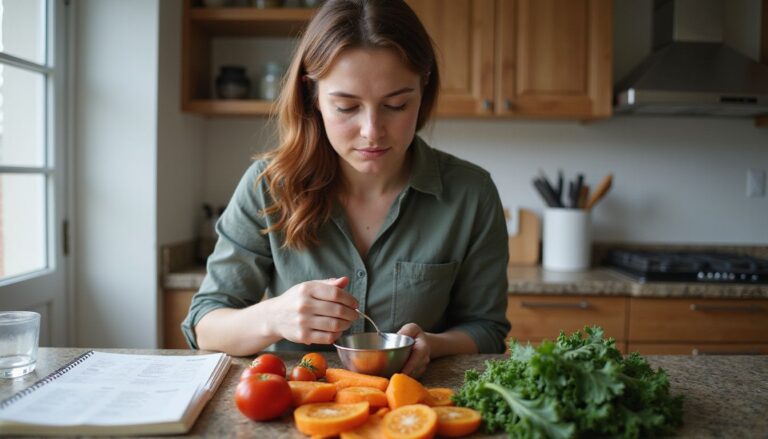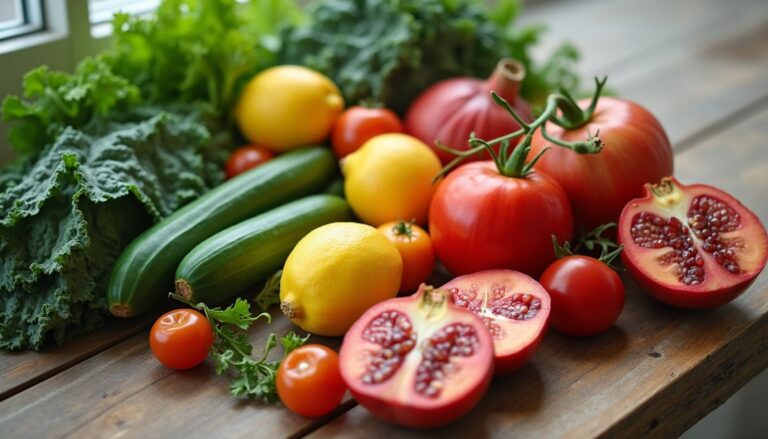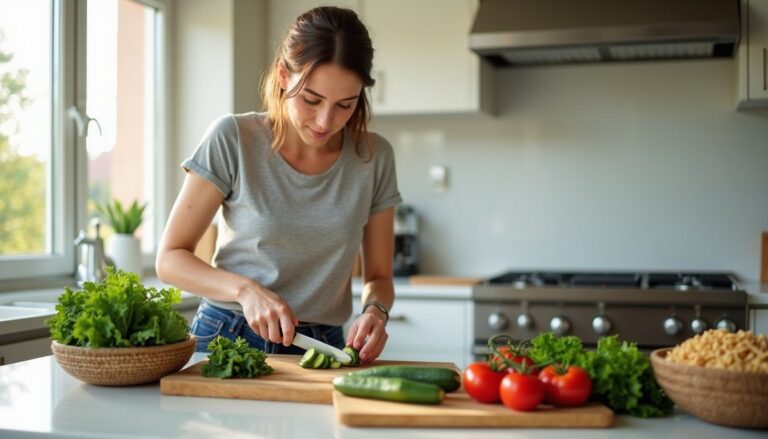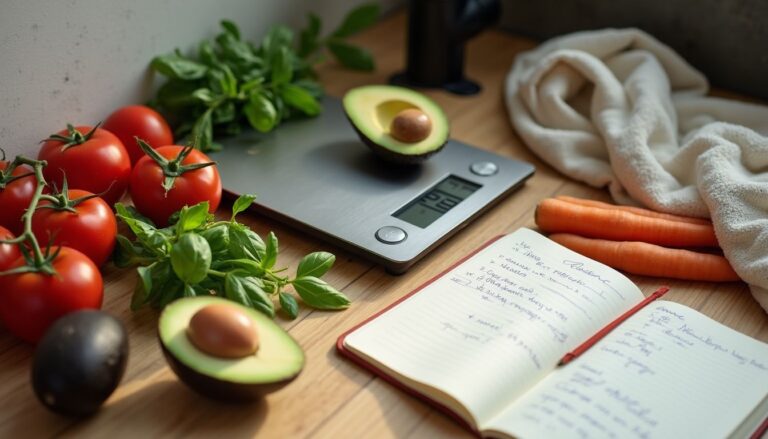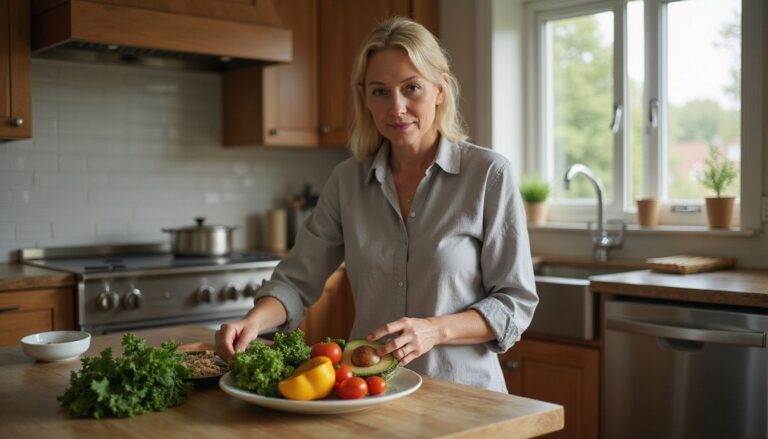Top Fruits Rich In Potassium: Your Ultimate Guide To High-Potassium Foods
Our Nutrition Assistant AI Suite will transform your body. You will lose fat, get toned, and build muscle. Gain confidence and optimal health.
Muscle cramps, low energy, or a fluttering heartbeat can signal low potassium. Potassium-rich foods help your nerves fire, muscles contract, and blood pressure stay in a healthy range.[1] Many people miss simple sources of potassium because they are unsure what to choose.
This guide highlights the best fruit sources of potassium. You will see how much potassium each serving provides and easy ways to add these foods to daily meals.
Use the tips below to make steady progress, one snack and smoothie at a time.
[1] U.S. Food & Drug Administration: Nutrition Facts Label – Nutrients: https://www.fda.gov/food/nutrition-education-resources-materials/nutrition-facts-label-nutrients
Key Takeaways
- Adults need about 4,700 mg of potassium per day. Strong picks include a medium banana at 422 mg, one cup sliced avocado at 708 mg, and a half cup dried apricots at about 1,100 mg.
- Potassium supports nerve, muscle, and heart function. Getting enough can help lower blood pressure and may reduce kidney stone and heart disease risk (FDA, 2023).
- Low potassium can cause cramps, fatigue, or an irregular heartbeat. Severe cases need medical care (Dr. Emily Johnson, US Nephrology Association).
- People with kidney disease or on certain medicines should track intake to prevent hyperkalemia, which can cause weakness, nausea, or dangerous heart rhythms.
- Coconut water at about 600 mg per cup and orange juice at about 500 mg per cup are helpful for hydration and electrolyte balance after activity.

What is potassium and why is it important?
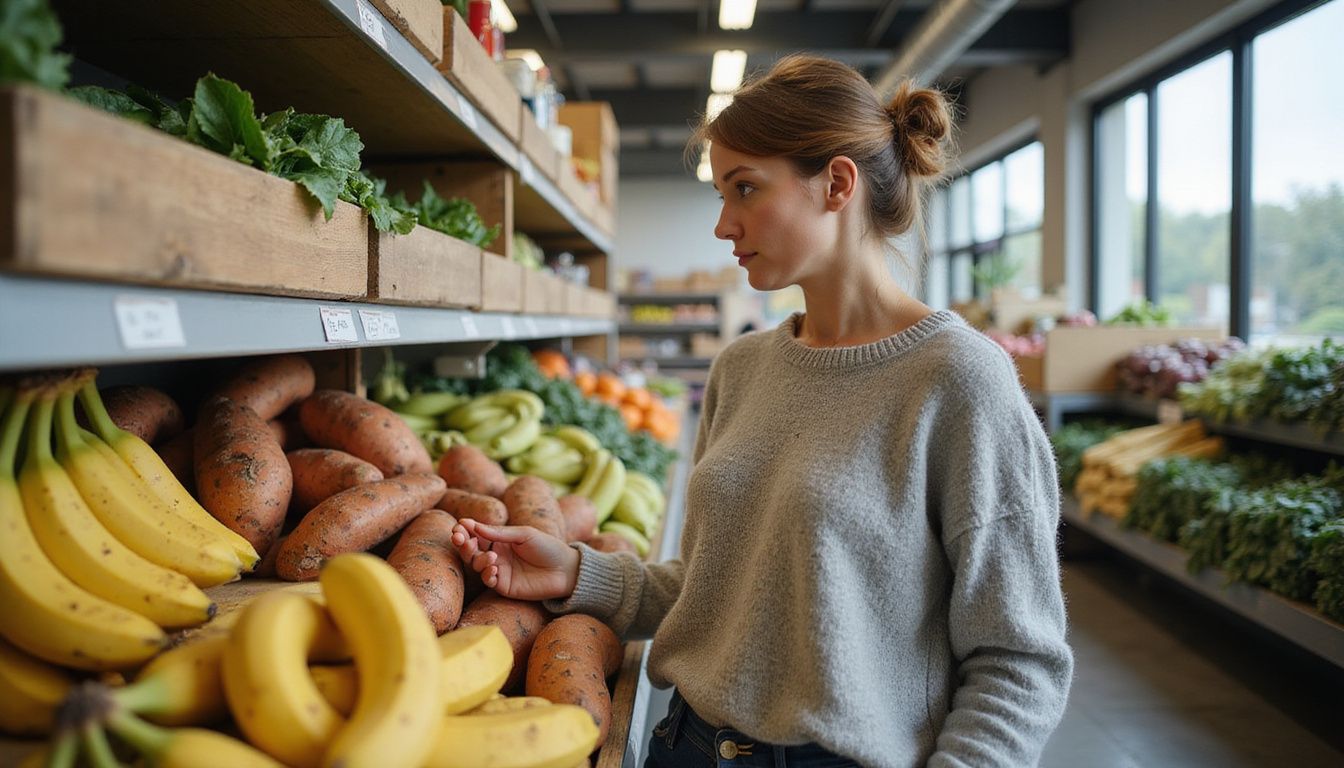
Potassium is a mineral and an electrolyte, which means it carries an electric charge that helps cells do their jobs. Your body needs it to move fluids, send nerve signals, and support muscle contractions. Eating enough supports a balanced diet and healthy kidneys.
What is potassium?
Potassium is a key mineral and electrolyte that keeps fluid levels steady and helps your nerves and muscles work. Common food sources include bananas, white beans, sweet potatoes, spinach, avocados, oranges, and lentils. Most adults need about 4,700 milligrams each day.
Your heart depends on potassium movement inside cells to keep a steady rhythm. The kidneys control blood potassium by removing extra amounts in urine. If you fall short, muscles can feel weak or cramp. Potassium also works with sodium, which can help support normal blood pressure.
What are the health benefits of potassium?
Getting enough potassium supports nerves and muscles, and it helps offset sodium’s effect on blood pressure. A diet rich in potassium is linked with better heart health and a lower risk of kidney stones. The Dietary Guidelines for Americans suggest aiming for about 4,700 mg per day for most adults.
Potassium also supports bone health by reducing mineral loss. It powers the sodium-potassium pump, a tiny cell mechanism that moves sodium out and potassium in, which keeps cells active and balanced.
With good daily intake, many people report fewer cramps and steadier energy. That steady supply can make workouts and busy days feel easier.
How much potassium do you need daily?
The FDA lists 4,700 milligrams as the Reference Daily Intake for most healthy adults. This level supports nerves, muscles, blood pressure control, and kidney health.
You can meet this goal with a wide range of plant foods, beans, seafood, and fruit. People with kidney disease or on certain medicines may need a lower target to avoid high potassium in the blood, called hyperkalemia. Talk with a healthcare professional if you have kidney failure or are considering potassium supplements.
What are the signs of potassium deficiency?
Low potassium levels can affect your routine in many ways. Spotting early signs helps you adjust your diet before problems grow.
Why do fatigue and weakness occur with low potassium?
Muscles need potassium to contract. Nerves need it to send signals. If your intake drops due to a low-potassium diet, illness, or certain medicines, you may feel tired or weak.
Low blood potassium weakens muscle contraction. It can slow the electrical signals that drive your heartbeat and movement. Both voluntary muscles, like your legs, and involuntary muscles, like the heart, can be affected.
Potassium helps keep our muscles strong and our bodies energized, says Dr. Emily Johnson from the United States Nephrology Association.
Even small drops can leave you worn out after minor effort. Day-to-day tasks may take more energy than usual.
How do muscle cramps relate to potassium levels?
Your muscles contract and relax using signals that depend on potassium. If your levels dip below the daily value of about 4,700 mg, cramps and spasms may appear.
Exercise and sweating increase mineral losses, which can worsen cramps. Choosing foods high in potassium, such as bananas, oranges, dried apricots, or pomegranates, helps restore balance. Some people notice fewer night cramps after they add more potassium-rich foods to meals.
Can potassium deficiency cause heart irregularities?
Low potassium does more than trigger cramps. It also disrupts the heart’s electrical system. Potassium works with calcium and magnesium in heart cells to control rhythm. When levels fall too low, irregular rhythms, called arrhythmias, can develop. Severe cases can be dangerous.
Palpitations or skipped beats can occur during low-potassium states. After a stomach virus led to fast fluid loss, my doctor checked my blood and explained the heart risks of low potassium.
People taking diuretics or on kidney dialysis have a higher risk of low blood potassium. Eating enough potassium from food helps maintain steady electrical activity in heart muscle.
Top fruits rich in potassium to include in your diet
Many fruits provide meaningful potassium. Add a few of these to reach your daily target with less effort.
How much potassium is in bananas?
A medium banana has about 422 mg of potassium, roughly 9 percent of the daily value. Bananas are low in sodium and easy to add to breakfast or snacks.
Slice one into oatmeal or yogurt after a workout to replace minerals lost in sweat. This simple habit can support muscle function and energy.
Are avocados a good source of potassium?
Yes. One cup of sliced avocado offers about 708 mg of potassium, more than a medium banana. That amount supports healthy blood pressure and muscle function.
Add avocado to salads, toast, or smoothies. If you have kidney disease, follow your care team’s guidance on portion size.
How rich are oranges in potassium?
A medium orange provides about 237 mg of potassium. One cup of orange juice contains about 496 mg. Oranges also supply vitamin C with very few calories.
People with kidney problems should ask their clinician before increasing high-potassium fruit intake.
Is watermelon a high-potassium fruit?
Watermelon contains potassium but is not among the top sources. One cup of diced watermelon has about 170 mg per cup, which is lower than bananas or avocados.
It is hydrating and refreshing, so enjoy it for fluids and vitamins. Choose higher-potassium fruits if you need to raise your numbers quickly.
What potassium content does cantaloupe have?
One cup of diced cantaloupe provides about 430 mg of potassium, close to 9 percent of the daily value. It is a gentle option if you prefer fruit that is easy on the stomach.
Since potassium helps control fluid balance and blood pressure, adding cantaloupe to a fruit bowl or salad can support heart and kidney health.
How much potassium do dried apricots contain?
Dried apricots are a standout choice. A half cup delivers about 1,100 mg of potassium, more than 20 percent of the daily target. They also contain fiber.
Stir chopped apricots into oatmeal or trail mix for a quick boost.
Are pomegranates high in potassium?
Yes. One medium pomegranate provides about 666 mg of potassium, over 14 percent of the daily value. The arils pair well with yogurt or salads and support heart and muscle function.
They are also rich in antioxidants, which support overall health.
How much potassium is in kiwi?
One medium kiwi contains about 215 mg of potassium. Two kiwis provide around 430 mg, close to 10 percent of your daily need. Kiwi also supplies vitamin C and fiber.
It works well in smoothies or sliced over cereal.
Does honeydew melon provide potassium?
Yes. One cup of diced honeydew has about 388 mg of potassium. This fruit helps regulate fluid balance and supports normal muscle activity.
Chill and cube for a quick snack or add to mixed fruit salads.
Is guava a good potassium source?
Guava is an excellent source. One cup of raw guava offers about 688 mg of potassium, more than an orange or apple. It supports heart health and blood pressure control.
Enjoy fresh slices, add to salads, or blend into a smoothie.
How much potassium does papaya offer?
One cup of fresh papaya contains about 264 mg of potassium. It offers a moderate amount, plus vitamins A and C.
Use papaya in smoothies or fruit bowls for color and variety.
Are mangoes rich in potassium?
One medium mango provides about 320 mg of potassium, around 7 percent of the daily value. While lower than bananas or dried apricots, mango still contributes to your total.
Combine mango with other potassium-rich fruits to raise your intake through the week.
Lesser-known fruits with high potassium levels
These options do not always get attention, yet they offer helpful amounts of potassium and add useful variety.
Does jackfruit contain potassium?
Yes. One cup of raw jackfruit provides about 739 mg of potassium. This supports normal blood pressure and steady nerve and muscle function.
Eat it fresh, blend into smoothies, or add to savory dishes for a nutrient boost.
Are raisins a good source of potassium?
A 1.5 ounce box of raisins, about 43 grams, supplies around 320 mg of potassium. They travel well and add natural sweetness without added sugar.
On long hikes, I mix raisins with peanuts for a quick snack. It helps me avoid cramps and steady my energy.
How rich in potassium are prunes?
Prunes, which are dried plums, provide about 635 mg in a half cup, around 13 percent of the daily value. They work well as a snack or stirred into oatmeal.
They can help prevent low-potassium symptoms like cramps and fatigue.
Do dates have significant potassium?
Yes. A half cup of dates contains about 500 mg of potassium. This fruit pairs well with yogurt or oatmeal for a sweet and mineral-rich addition.
Chop a few into a smoothie for a natural lift without added sugar.
How can you add high-potassium fruits to your meals?
Small changes add up. Use these easy ideas to raise your daily potassium without a big overhaul.
What are easy smoothie recipes with potassium fruits?
Blend one banana, half an avocado, and one cup of spinach with a cup of coconut water. This mix provides well over 1,200 mg of potassium in a single glass.
For variety, blend watermelon and mango with plain Greek yogurt. Add orange or kiwi for more flavor and extra potassium.
How to make salads with high-potassium fruits?
Start with leafy greens like spinach or arugula. Add sliced banana, orange segments, kiwi, and mango for natural sweetness and potassium.
Toss in avocado for a bigger boost, then sprinkle pomegranate seeds on top. A light dressing of olive oil and lemon juice keeps sodium low and flavor bright.
What are healthy snack ideas with potassium-rich fruits?
Stir sliced banana and chopped dried apricots into plain Greek yogurt. Pack orange wedges with a small handful of raisins for school or work.
Make a quick fruit cup with kiwi, mango, and papaya. Mash avocado on whole grain toast, then add thin banana slices for a fast, filling bite.
Can eating too much potassium be harmful?
Yes. Too much potassium can be risky, especially for certain health conditions. Know your personal limits and check medications that affect potassium balance.
What are the risks of excess potassium?
High potassium, called hyperkalemia, can cause nausea, weakness, or an irregular heartbeat. If levels spike, chest pain or severe palpitations can occur. In rare cases, the heart can stop, which is a medical emergency.
People with kidney problems are at higher risk because the kidneys may not remove extra potassium well. I cared for someone with chronic kidney disease who felt nauseated and crampy after several very high-potassium meals. Careful tracking helped prevent repeat episodes.
Who needs to monitor their potassium intake?
People with kidney disease should follow a care plan that limits certain high-potassium foods. Those on ACE inhibitors, some diuretics, or heart medicines may also need to monitor intake.
Conditions such as Addison’s disease or poorly managed diabetes can raise potassium. Regular blood tests help keep levels safe and avoid rhythm problems.
What are some potassium-rich beverages to try?
Beverages can deliver meaningful potassium, which supports daily nutrition alongside food choices.
Is coconut water high in potassium?
Yes. One cup of coconut water offers about 600 mg of potassium, or roughly 13 percent of the daily value. It is a simple option for hydration after workouts or hot days.
During a summer picnic, I swapped soda for coconut water and had fewer cramps after playing sports.
Which fresh fruit juices provide potassium?
One cup of orange juice provides about 500 mg of potassium. Pomegranate juice offers around 530 mg per cup. Grapefruit juice has about 400 mg, and watermelon juice gives around 275 mg per glass.
Guava and mango juices also land above 300 mg per cup. For a homemade option, blend a banana with milk or water to raise your total.
Conclusion
Fruits are reliable sources of potassium that fit into any routine. Bananas, avocados, pomegranates, and dried apricots make it easier to reach the daily goal. Simple snacks and smoothies help you stay consistent.
Coconut water and fresh juices add a useful lift, especially after exercise. If you have kidney disease or take certain medicines, check with a clinician about your personal target. With smart choices, potassium-rich foods can support steady energy, strong muscles, and a healthy heartbeat.
FAQs
1. Which fruits are highest in potassium and how do they compare to yam?
Bananas, oranges, cantaloupe, apricots, and prunes are among the top fruits rich in potassium. For example, a medium banana contains about 422 mg of potassium while one cup of sliced cantaloupe offers around 427 mg. In comparison, yam is a vegetable but it also provides significant potassium; one cup of cooked yam has roughly 911 mg.
2. Why is eating high-potassium foods like certain fruits and yam important for health?
Potassium helps maintain healthy blood pressure levels and supports muscle function according to the National Institutes of Health (NIH). Consuming high-potassium foods such as bananas or yams can lower the risk of stroke and heart disease.
3. How much potassium should adults get daily from sources like fruit or vegetables including yam?
The recommended daily intake for most adults is about 2,600 to 3,400 milligrams depending on age and sex based on NIH guidelines. Eating a variety of fruits along with vegetables such as yams can help meet this goal.
4. Can you share an easy way to add more high-potassium foods like fruit or yam into meals?
Adding sliced bananas or orange segments to breakfast cereal increases your intake easily. Roasting diced yams with olive oil makes a simple side dish that boosts dietary potassium content.
Summary: Fruits such as bananas and oranges provide substantial amounts of potassium per serving; however, vegetables like yams offer even higher concentrations per cup cooked. Including these options regularly supports cardiovascular health through adequate mineral intake supported by scientific research (NIH).


